- By Sarju Saran Tiwari
- Tue, 04 Nov 2025 05:42 PM (IST)
- Source:JND
October Month Most Polluted Cities In India: Air pollution is one of the most worrying health and environmental challenges across India. The main causes of air pollution are the burning of fossil fuels, automobiles, agricultural activities, factories, and industries. It is life-threatening and can have long-term effects on the human body.
According to the monthly air quality snapshot released by the Centre for Energy and Clean Air Research (CREA) on November 4, Dharuhera in Haryana was the most polluted city in India during October 2025. The report further said that all the 10 most polluted cities in India during October were located in the National Capital Region (NCR).
The monthly average concentration of PM2.5 in Dharuhera was 123 micrograms per cubic meter (μg/m³), exceeding the National Ambient Air Quality Standards (NAAQS) limit on 77 per cent of days.
Meanwhile, Shillong, the capital of Meghalaya, was the cleanest city in India in October, with an average PM2.5 concentration of 10 μg/m³. The top 10 cleanest cities included four from Karnataka, three from Tamil Nadu, and one each from Meghalaya, Sikkim, and Chhattisgarh.
India's Top 10 Most Polluted Cities: October 2025 (NCR Dominates)
According to the Centre for Research on Energy and Clean Air (CREA)’s Monthly Air Quality Snapshot, all of India's 10 most polluted cities in October 2025 were located within the National Capital Region (NCR) and the Indo-Gangetic Plain.
Rank | City Name |
1 | Dharuhera |
2 | Rohtak |
3 | Ghaziabad |
4 | Noida |
5 | Ballabgarh |
6 | Delhi |
7 | Bhiwadi |
8 | Greater Noida |
9 | Hapur |
10 | Gurgaon |
Seasonal Spikes Expose Year-Round Pollution Crisis:
The winter and festive seasons don't just create the pollution problem in India, they truly expose it. These seasonal spikes exacerbate baseline pollution levels that remain dangerously high year-round. This projected surge could be largely prevented if we prioritize sector-specific emission reductions with clear accountability mechanisms. Instead, policy responses remain reactive and seasonal, failing to address the year-round sources that exacerbate this crisis, said Manoj Kumar, analyst at CREA.

